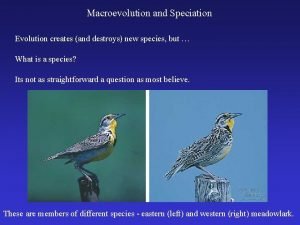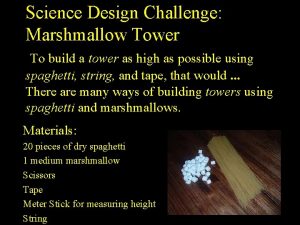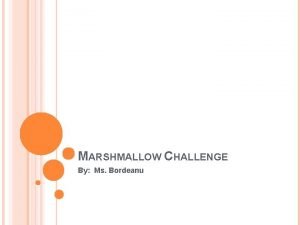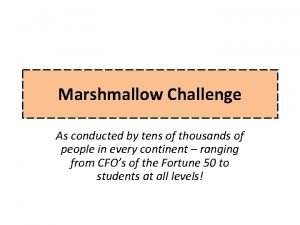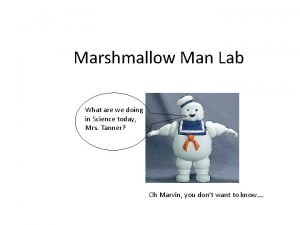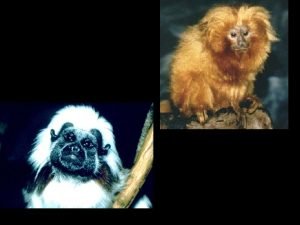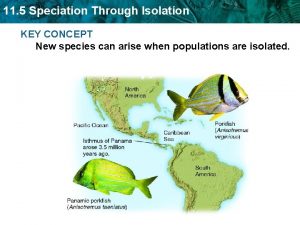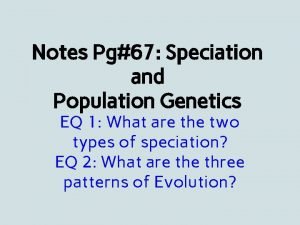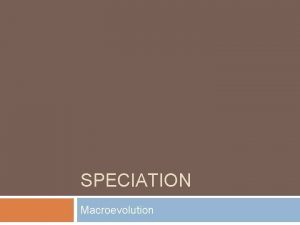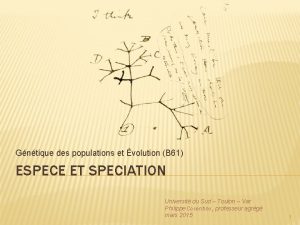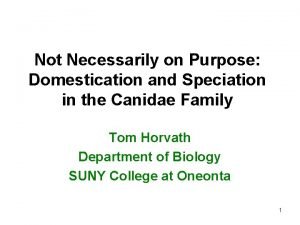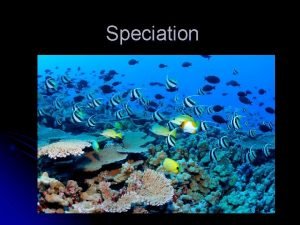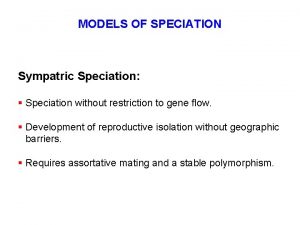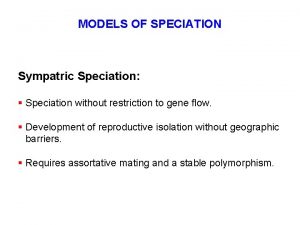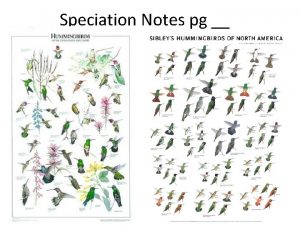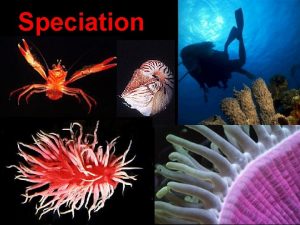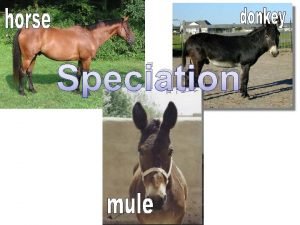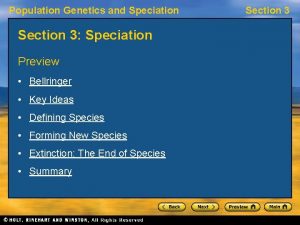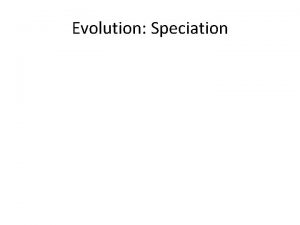Speciation Outline Marshmallow Challenge Speciation Marshmallow Challenge In






















- Slides: 22

Speciation

Outline • Marshmallow Challenge • Speciation

Marshmallow Challenge • In science, scientists often work as a team – Able to work with all different people – To do research – Publish papers This activity will test your team-working skills

Marshmallow Challenge • Purpose: build the tallest freestanding structure using the materials provided in 15 minutes • Materials: – 20 sticks of pasta – 1 meter of tape – 1 marshmallow Condition: the marshmallow has to be at the very top

Species? • What is a species? – Difficult to define – Organisms that can interbreed under natural conditions and produce viable offspring Are lions and tigers the same species? Why?

Speciation • Formation of new species • Modes: – Reproductive isolation – Allopatric speciation – Sympatric speciation

Mechanisms of Reproductive Isolation • • Must evolve to become reproductive isolated from the original population Reproductive isolating mechanism: – Any factor that prevents two populations from interbreeding when living in the same region 1) Prezygotic mechanisms 2) Postzygotic mechanisms

Prezygotic Mechanisms • 1) 2) 3) 4) 5) Prevent fertilization and zygote formation Behavioural Temporal Ecological Mechanical Gametic

• Behavioural – the behaviours of organisms are not recognized by each other – E. g. mating calls of frogs • Temporal – breed at different times of the year – E. g. flowering times of certain plants • Ecological – species are physically separated thus occupy different areas – E. g. birds that prefer higher or lower elevations

• Mechanical – incompatible reproductive organs – E. g. different species of damselflies have uniquely shaped genitalia • Gametic – gametes do not recognize each other – E. g. sperms of clams will not fertilize sea cucumbers’ eggs

Postzygotic Mechanisms • Prevent fertilized egg from growing into a viable and reproducing adult 1) Zygotic mortality 2) Hybrid inviability 3) Hybrid infertility

• Zygotic mortality – after fertilization, zygote dies – Zygote of sheep and goat is not viable • Hybrid inviability – hybrid develops but dies before birth or cannot survive until maturity – Tigers and leopard hybrids ends in miscarriage or stillborn • Hybrid infertility – hybrid is healthy but infertile – Mules are infertile

Examples of hybrids that are fertile! • • Wholphin Grizzly-polar bear Cama Coywolf

Allopatric Speciation • Formation of new species due to long period of geographic isolation • Gradually become less and less alike – No genetic information exchange – No shared mutations – Experience different natural selection

Examples • Finches on Galapagos Islands • Asian elephants – has 4 distinct subspecies

Sympatric Speciation • Evolution of populations into separate species in the same geographic area • Example: – Hawthorn flies lay eggs in the fruits of hawthorn trees – After apple trees were introduced, some of the flies would lay eggs in the apples – Today, the species are now consist of two distinct populations

Divergent Evolution • Evolution of a group into many forms • All come from a single common ancestor • Rodents: – Deer mouse – Flying squirrel – Porcupine – beaver

Convergent evolution • Evolution of similar traits in distantly related species • Can be predicted like divergent evolution • Examples: – Euphorbia and cacti evolved similar features in response to hot, dry environments – Sharks and dolphins evolved similar stream-lined bodies

Coevolution • One species evolves in response to the evolution of another species • Example: orchid and moth – Orchid require moth to pollinate the flowers – Moth depends on orchid for nectar – Over time, orchid evolved extremely long tubes and moth developed long tongue – Moth will spend more time obtaining nectar and thus making them more likely to pick up pollen

Figure 8 on pg. 344

Homework Questions • Section 7. 4: #4 -8 • Section 8. 2: #1 -5

Exit Card • Come up with at least one question that you are not very clear about on speciation. Please make the question and the writing as clear as possible.
 Antelope squirrel allopatric speciation
Antelope squirrel allopatric speciation For four people
For four people Marshmallow challenge best design
Marshmallow challenge best design Marshmallow challenge solution
Marshmallow challenge solution Marshmallow challenge statistics
Marshmallow challenge statistics Carly hanson
Carly hanson Fallon sherrock smoking
Fallon sherrock smoking Quote sandwich format
Quote sandwich format Eiffel tower made of toothpicks
Eiffel tower made of toothpicks Function of the frontal lobe
Function of the frontal lobe Ode to a marshmallow
Ode to a marshmallow Best spaghetti marshmallow structure
Best spaghetti marshmallow structure Marshmallow launcher design
Marshmallow launcher design In marshmallow muscles what is the independent variable
In marshmallow muscles what is the independent variable Marshmallow
Marshmallow Don't eat the marshmallow yet
Don't eat the marshmallow yet Marshmallow man lab
Marshmallow man lab How does speciation occur
How does speciation occur Reproductive isolation
Reproductive isolation Genetic drift
Genetic drift Speciation process
Speciation process Scala naturae
Scala naturae Canidae cladogram
Canidae cladogram
